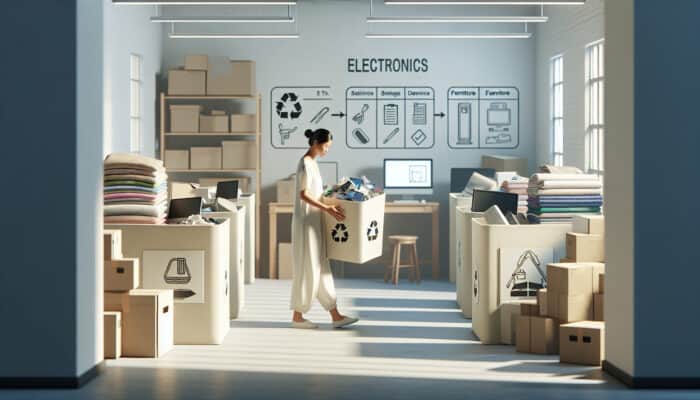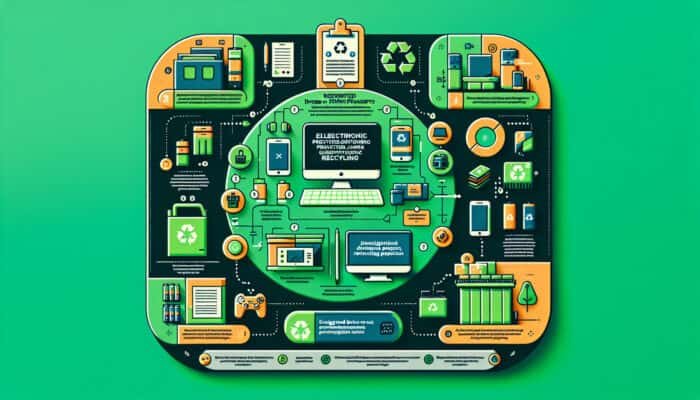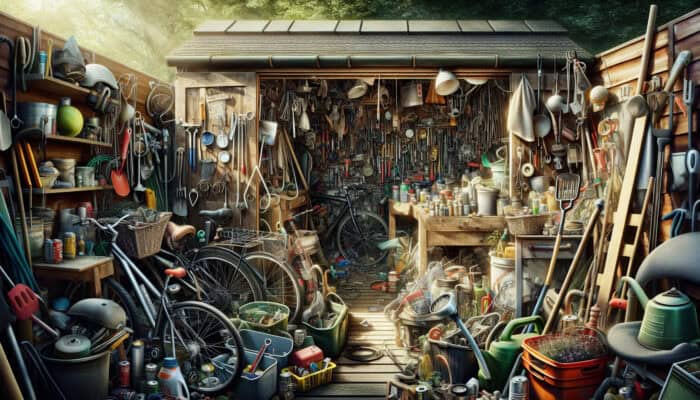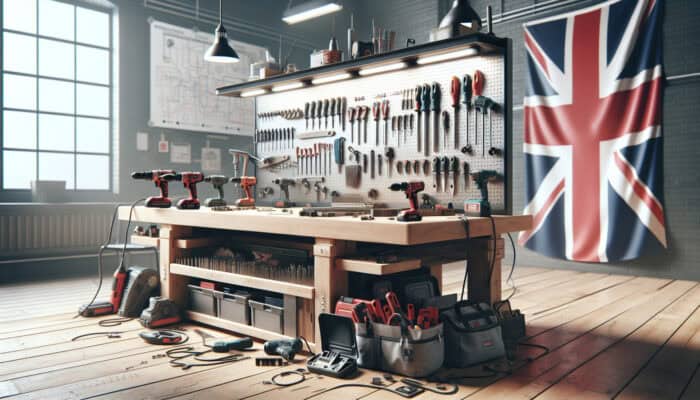Preparing for Spring House Clearance
Sorting Your Items

Spring Recycling Tips for House Clearance: To embark on an effective spring house clearance, the first step is to sort your items. This process begins by identifying key categories for various belongings, such as electronics, textiles, and furniture. By distinguishing items into these groups, you can streamline the recycling process, making it easier to determine what can be reused, donated, or discarded.
Start with electronics, which often include televisions, computers, and various gadgets. These items typically require specialised recycling methods due to their hazardous materials, so placing them in a designated pile is crucial. Next, textiles should be sorted into categories such as clothes, curtains, and upholstery. Many charities accept clean, usable textiles, while worn-out items can often be recycled into new fabric products. Lastly, assess the condition of each piece of furniture. Items in good condition could be donated to charities or sold, while those beyond repair may need to be recycled or disposed of through a local waste service.
In addition to sorting by category, consider creating subcategories within each main group. For instance, within electronics, you might separate cables and accessories from the main devices. This not only helps with recycling but also helps keep your space organised as you work through the clearance.
What Can Be Recycled in the UK?
Understanding what can be recycled is vital for any house clearance in the UK. Each local council may have specific guidelines, so it’s essential to check these for precise information. However, there are common materials that are generally accepted at UK recycling centres. Knowing these can significantly enhance your recycling efforts.
Here’s a bullet list of common recyclable materials in the UK:
- Plastics (bottles, containers, and packaging)
- Glass (bottles and jars)
- Metals (cans and foil)
- Paper and cardboard (newspapers, magazines, and boxes)
- Textiles (clothes and bedding)
- Batteries (household and vehicle)
- Electrical items (small appliances and gadgets)
- Garden waste (branches, leaves, and grass clippings)
Make sure to rinse out containers, especially plastic and glass containers, as contamination can lead to entire batches being rejected during recycling. Additionally, check whether your local council provides specific facilities for items such as batteries and electrical appliances, as these often require special handling. This knowledge allows you to maximise recycling and minimise waste significantly during your spring clearance.
How to Schedule a House Clearance?
Scheduling a house clearance is a crucial step that requires some planning and foresight. Begin by contacting local waste management services or professional clearance companies to discuss your needs. Be sure to book in advance, especially during peak spring times when demand for these services tends to increase.
When reaching out to these services, provide a clear description of the items you wish to clear out. This will help them give you an accurate quote and advice on the best options available. If you’re considering a professional service, look for companies that offer eco-friendly options or are certified by recognised waste management associations. This ensures they practice responsible recycling and disposal methods.
It’s also wise to check whether your local council offers any collection services for certain types of waste. Many councils provide scheduled collection days for large items like furniture, which can save you the hassle of organising private services. Always confirm the dates, as some councils operate on specific schedules throughout the year. By being proactive in scheduling, you can ensure a smooth and efficient clearance process that aligns with your timetable.
Expert Insights on Spring Recycling Tips for House Clearance

Include Real-World Examples from UK Experts
Learning from those who have successfully navigated house clearances can be immensely beneficial. UK recycling experts often share their experiences and insights, which can help you make effective recycling decisions.
For instance, experts recommend starting early in the season to avoid the rush that typically occurs in late spring. Mark Mullen, a prominent figure in eco-friendly waste management, emphasises the importance of a clear plan. He advocates for using a checklist to track items and ensure nothing is overlooked. Another tip from Sarah Collins, a local recycling advocate in London, is to engage friends or family in the process. The extra hands not only speed up the clearance but can also bring new perspectives on what can be recycled or reused.
Here’s a bullet list of expert tips for house clearance in the UK:
- Start with a plan: Outline what items you’ll sort and how you will dispose of them.
- Involve others: Gather friends or family to help with the process.
- Utilise local resources: Check council services or community initiatives for recycling.
- Document your progress: Keep a checklist to ensure all items are accounted for.
- Be mindful of hazardous waste: Identify and separate hazardous materials early.
By following these expert insights, you can enhance your house clearance efficiency and ensure that you’re making environmentally responsible choices throughout the process.
Provide Actionable Steps for Efficient Clearance
Implementing an actionable plan is key to ensuring your house clearance is both efficient and environmentally friendly. Start by creating a timeline for your clearance, breaking it down into manageable tasks. For instance, you might dedicate one weekend to sorting through your living room and another to sorting through your bedroom. This segmentation helps prevent overwhelm and allows you to track your progress effectively.
Once your timeline is established, gather the necessary supplies, such as boxes or bins for sorting, labels for categorisation, and cleaning materials for preparing items for recycling or donation. A crucial step involves determining what is worth keeping and what can be discarded. Ask yourself questions like whether the item has been used in the past year or if it holds significant sentimental value. If it does not meet these criteria, it may be time to let it go.
Next, be systematic in your sorting process. Follow your categories and subcategories, and avoid mixing items. This will simplify your later decisions on recycling or donating. Be vigilant with hazardous materials; for instance, if you encounter old paint or chemicals, set these aside for special disposal as outlined in your local guidelines. By following these structured steps, you’ll find that your house clearance is much more straightforward and productive.
What Are the Best Practices for Recycling Electronics?

Recycling electronics presents unique challenges because their components can often be hazardous. Thus, understanding best practices is essential to safely recycling items such as computers, phones, and batteries in the UK. First and foremost, never dispose of electronics in regular rubbish, as they can leak harmful substances into the environment.
Begin by identifying recycling options available in your area. Many local councils have designated drop-off points for electronic waste, while retailers like Currys PC World often offer take-back schemes for old gadgets when purchasing new items. Additionally, organisations such as The Recycling Factory accept a wide range of electronic items for recycling by post, which can be a convenient option if you have several items to dispose of.
When preparing electronics for recycling, ensure that all personal data is erased from devices. For computers and phones, a factory reset or data wipe is advisable. It’s also wise to keep original packaging or cords together, as some recycling facilities may require these to process the item efficiently. Following these best practices not only ensures compliance with UK regulations but also contributes to a more sustainable approach to electronics disposal.
Local Recycling Facilities in the UK
Finding Your Nearest Recycling Centre
Locating a recycling centre near you is essential for an effective house clearance. Various online tools and local council websites can help you find recycling facilities in your area. Most councils provide interactive maps that allow you to enter your postcode and identify nearby centres, along with details about what materials each centre accepts.
Once you’ve identified potential sites, check whether they accept the types of waste you wish to dispose of. Some centres may focus on specific materials, while others might cater to a broader range. If you’re uncertain, don’t hesitate to contact the facility directly to clarify their accepted items.
In addition, consider the opening hours and any specific drop-off requirements. Some centres may require proof of residency, especially for more significant items. Being aware of these factors in advance can save you time and ensure a smoother recycling experience. Ultimately, knowing where to go enables you to actively participate in sustainable practices, making a positive impact on your local environment.
What Services Do UK Recycling Centres Offer?
UK recycling centres offer several services to help residents manage their waste efficiently. Typical offerings include drop-off services for various materials, including plastics, metals, glass, and garden waste. Many centres are also equipped to handle larger items, such as furniture and electrical appliances, making them a one-stop shop for your recycling needs.
In addition to basic drop-off services, some recycling centres offer collection services for those unable to transport their items. This can be particularly helpful for larger households or individuals with mobility issues. Moreover, many facilities host special events or initiatives, such as clean-up days, which encourage local participation in recycling efforts.
It’s also worth noting that some centres provide educational resources about recycling practices, helping you to make informed decisions about your waste. Engaging in these community activities can foster a greater sense of responsibility toward the environment and build connections with neighbours who share similar goals. By utilising the diverse services offered by recycling centres, you can effectively manage your household waste while supporting sustainable practices.
How Can I Recycle Furniture in the UK?
Recycling furniture can often be daunting, particularly for larger items like sofas and wardrobes. However, there are several avenues available in the UK, ranging from charitable donations to specialised recycling programmes. Before you dispose of any piece of furniture, assess its condition; items that are still functional can be donated to charities or sold second-hand.
Charitable organisations across the UK, such as the British Heart Foundation or Emmaus, accept donations of good-quality furniture. They often offer collection services, making it convenient for you to dispose of your unwanted items. If your furniture is beyond repair, consider contacting local councils to inquire about bulk waste collection services. Many councils offer scheduled collection days specifically for large items, ensuring they are disposed of responsibly.
For those interested in upcycling, numerous local workshops teach furniture restoration techniques. Transforming an old piece gives it a new lease on life and helps reduce waste. If upcycling isn’t an option, ensure your furniture is taken to a recycling facility that can handle the materials responsibly. Many recycling centres are equipped to break down furniture into reusable components, thereby minimising environmental impact. By exploring these options, you can responsibly recycle your furniture while contributing to sustainability efforts.
Charitable Donations and Reuse Options
Which UK Charities Accept Donations?
When decluttering your home, donating items to charity is an excellent way to give back to your community while also promoting recycling. Numerous UK charities accept a wide array of goods, including furniture, clothes, and electronics. Local charities like The Salvation Army, Oxfam, and Age UK have established processes for accepting donations and often provide collection services to make the process easier for donors.
Additionally, many charities operate shops where donated items are sold to raise funds for their causes. This not only supports your chosen charity but also provides others with an opportunity to find affordable second-hand goods. It’s worth researching specific charities in your area that align with the causes you care about, so your donations have the greatest impact.
Remember to check each charity’s guidelines for accepted items, as some may have restrictions. For instance, certain organisations may not accept large furniture or specific electronics due to logistical challenges. By being informed and proactive, you can ensure that your donations are meaningful and beneficial to both the charity and the environment.
How to Prepare Items for Donation?
Preparing items for donation is an important step that can significantly increase the likelihood that they will be reused. Begin by thoroughly cleaning each item, as many charities prefer donations to be in good condition. For clothing, make sure they are washed and free of stains or odours. For furniture, a quick clean and minor repairs can increase its appeal and usability.
Additionally, check for any missing parts or broken components, especially for electronics and appliances. If an item is in disrepair, it may be more beneficial to recycle it than donate it. To streamline the donation process, consider creating a list of items you intend to donate, noting their condition. This helps organisations assess what they can accept more efficiently.
To help you prepare your items for donation, here’s a bullet list of preparation steps:
- Clean all items to ensure they are presentable.
- Repair minor damages where feasible.
- Check for completeness of items (e.g., accessories, parts).
- Sort items by category for easier processing.
- Label boxes or bags clearly to indicate contents.
By taking these steps, you can enhance the effectiveness of your donations and ensure that they find new homes quickly and efficiently.
Benefits of Donating to UK Charities
Donating to UK charities offers multiple benefits that extend beyond simply decluttering your home. First and foremost, it directly supports local communities and those in need. Many charities rely on donations to fund their operations and provide vital services, including food banks, housing support, and education.
Moreover, donating to charities fosters a sense of community and encourages a culture of giving. It creates opportunities for others to benefit from your unwanted items while promoting a sustainable approach to consumption. Beyond the immediate community benefits, donating helps reduce landfill waste. The more people donate, the less likely usable items will end up in rubbish tips, contributing to environmental preservation.
Additionally, many charities offer gift aid, enabling you to increase the value of your donations without incurring any extra cost. This means that for every £1 you donate, charities can claim an additional 25p from the government, bolstering their resources. By donating to charities, you enter a positive cycle of giving that supports both individuals and the environment, amplifying your impact significantly.
Research-Backed Benefits of Spring Recycling Tips for House Clearance
Offer Expert Analysis on Environmental Impact
Understanding the environmental impact of recycling during house clearance is crucial for making informed decisions. Recycling reduces the volume of waste sent to landfills, thus preserving valuable space and reducing the need for new landfill sites. Experts agree that recycling materials significantly lowers greenhouse gas emissions compared to producing new products from raw materials.
For instance, recycling aluminium saves up to 95% of the energy required to create new aluminium from bauxite ore. Similarly, recycling paper reduces deforestation and conserves water, making it a critical practice for environmental conservation. By choosing to recycle during your spring clearance, you help reduce the carbon footprint associated with manufacturing processes.
Moreover, public awareness campaigns indicate that increased recycling rates can create green jobs in the UK. As recycling facilities expand to meet growing demand, they create opportunities for employment in sustainable industries. Ultimately, by engaging in responsible recycling practices, you become a key player in the broader movement towards environmental sustainability and responsible resource management.
How Does Recycling Reduce Landfill Waste?
Recycling plays a pivotal role in reducing landfill waste, a vital consideration as the UK grapples with waste management challenges. When recyclable materials are diverted from landfills, they not only conserve space but also limit the environmental hazards associated with waste decomposition, such as methane emissions—a potent greenhouse gas.
In fact, the UK has set ambitious recycling targets, aiming to recycle 65% of municipal waste by 2035. This goal underscores the importance of collective efforts in recycling initiatives, including individual actions such as those during spruce-ups. Each small contribution counts, as the cumulative effect of increased recycling reduces overall waste sent to landfills.
Additionally, recycling reduces the burden on landfills, prolonging their lifespan and decreasing the need for new sites, which can be both environmentally disruptive and costly. By proactively recycling during house clearance, you help build a more sustainable future and alleviate pressure on the UK’s waste management systems.
What Are the Economic Benefits of Recycling?
The economic benefits of recycling are considerable and far-reaching for the UK economy. Engaging in effective recycling practices can stimulate job creation in green industries, as recycling facilities require a workforce to process materials. According to industry analyses, the recycling sector provides thousands of jobs across various roles, from collection to processing and sales of recycled materials.
Moreover, recycling reduces costs associated with waste management. By decreasing the volume of waste sent to landfills, local councils can save on disposal fees. These savings can then be redirected towards community services or infrastructure improvements. Additionally, recycling can lower raw-material prices, as recycled materials are often cheaper than virgin alternatives. This benefits businesses and consumers alike, creating an economically sustainable cycle.
Furthermore, investments in recycling technology and infrastructure can yield significant economic returns. The development of innovative recycling solutions fosters competition, driving efficiency and sustainability across various sectors. Thus, by embracing recycling during your spring house clearance, you not only contribute positively to the environment but also support economic growth and resilience within your community.
How Can Spring Recycling Improve Mental Well-being?
Engaging in spring recycling during house clearance can have profound effects on mental well-being. Decluttering and organising your space not only provides a sense of achievement but also promotes feelings of control and calm. Studies suggest that living in a clutter-free environment can significantly reduce stress and anxiety levels, creating a tranquil atmosphere conducive to mental clarity.
Moreover, participating in recycling and sustainable practices often fosters a sense of purpose. Knowing that your efforts contribute to environmental protection and community support can boost self-esteem and satisfaction. Many individuals report feeling happier and more fulfilled when they take active steps towards making a positive impact, creating a ripple effect of positivity in their lives.
Additionally, engaging in physical activity during the clearance process can also promote mental health. The combination of moving around, lifting items, and deciding what to keep or recycle provides an outlet for physical energy and can enhance mood. By embracing spring recycling during your house clearance, you not only benefit the environment but also nurture your mental well-being, leading to a healthier, happier lifestyle.
Special Considerations for Hazardous Waste
Identifying Hazardous Materials in Your Home
Identifying hazardous materials in your home is crucial for responsible house clearance. Items such as paints, chemicals, batteries, and fluorescent bulbs can pose potential risks if not handled properly. Recognising these materials can help prevent environmental contamination and ensure your safety during the clearance process.
Begin by checking common household areas, such as the garage, shed, and under the sink. Products such as paint thinners, pesticides, and cleaning agents often contain hazardous chemicals that require special disposal. Additionally, old appliances containing refrigerants should be handled with caution, as they can be harmful to the environment if improperly released.
To ensure safe handling, label any hazardous items clearly and keep them separate from other waste. This not only aids in your sorting process but also helps inform others who may assist you in the clearance. Understanding which materials require special attention is essential for promoting safety and compliance with UK waste regulations.
Where to Dispose of Hazardous Waste in the UK?
Disposing of hazardous waste in the UK must be done through designated facilities equipped to handle such materials safely. Each local council typically provides information on where residents can take hazardous items, often through their waste management departments. Many councils have dedicated collection points or host seasonal hazardous-waste collection events, allowing residents to drop off items safely.
Some recycling centres also accept hazardous materials, but it’s vital to check beforehand what they can take. Products like batteries and electronics usually require separate disposal methods, and many retailers offer take-back schemes for items such as mobile phones and laptops.
Using these resources not only ensures that hazardous materials are disposed of properly but also protects the environment and public health. By proactively identifying the right disposal channels, you can help create a safer, cleaner community.
How Can I Safely Transport Hazardous Waste?
Transporting hazardous waste safely to disposal sites is essential for preventing accidents and environmental contamination. Begin by ensuring that items are securely packaged in appropriate containers. For liquids, use sealed bottles or jars that won’t leak during transport. For batteries and small electronics, use original packaging or a sturdy box to prevent damage.
When loading hazardous materials into your vehicle, make sure they are placed upright and secured to avoid movement during transit. It’s advisable to keep hazardous items separate from regular household waste and personal items to reduce the risk of exposure to harmful substances.
Always adhere to UK regulations regarding the transport of hazardous materials. If you’re unsure about specific requirements, consult your local council or waste management authority for guidance. Following these safety measures not only protects you during transport but also ensures that hazardous waste is handled responsibly upon arrival at its disposal site.
Upcycling and Repurposing Ideas
Creative Ways to Upcycle Old Furniture
Upcycling old furniture presents an exciting opportunity to transform discarded pieces into new, functional items. The UK is home to a vibrant upcycling community, with many enthusiasts sharing unique projects that inspire creativity. A simple wooden chair, for example, can be revitalised with a fresh coat of paint and new upholstery, turning it into a striking feature piece in any room.
Consider repurposing old drawers into stylish storage solutions. A vintage drawer can be mounted on the wall as a decorative shelf, adding both storage and character to your space. Additionally, pallets can be upcycled into coffee tables or garden benches, offering rustic charm while promoting sustainability.
Local workshops often host upcycling classes, allowing individuals to learn skills ranging from furniture painting to carpentry. Engaging in these community activities not only enhances your crafting abilities but also provides a platform for sharing ideas and inspiration. By exploring creative ways to upcycle your furniture, you can help reduce waste while adding personalised touches to your home.
What Materials Are Best for Repurposing?
When it comes to repurposing, certain materials stand out for their versatility and durability. Wood, metal, and certain plastics are excellent choices for crafting new items. Wood, for example, is a timeless material that can be transformed into anything from shelving units to garden planters. Its aesthetic appeal and structural integrity make it a favourite among upcyclers.
Metal items, such as old tins or furniture, can be easily transformed into decorative or functional pieces. For instance, a rusted metal chair can be painted and used as a quirky plant holder, while old tins can be converted into storage containers or wall art.
Plastics, particularly sturdy ones, can also be repurposed creatively. Containers can be transformed into planters or storage boxes, while plastic bottles can be used for various DIY projects, including bird feeders or garden decorations. By opting for these materials, you can explore numerous repurposing ideas that are both practical and environmentally friendly.
How to Start Your Own Upcycling Project?
Starting your own upcycling project can be an enjoyable and rewarding experience that breathes new life into old items. Begin by choosing a piece of furniture or material that you feel inspired to transform. Assess its potential and think creatively about how it can be repurposed. Take time to sketch out your ideas or gather inspiration from online platforms like Pinterest or Instagram.
Next, gather the necessary tools and materials for your project. Basic tools such as sandpaper, paint brushes, and adhesive are often sufficient for many upcycling tasks. If you’re working with wood, consider investing in a good-quality primer and finish to ensure durability.
Once you’re equipped, carefully plan your execution. Set aside dedicated time to work on your project and ensure your workspace is clean. As you progress, don’t hesitate to adapt your ideas based on what works best. The beauty of upcycling lies in its flexibility—embrace the creative process! As you complete your project, please share your results with the upcycling community and inspire others to embark on their own transformation journeys.
Successful UK Upcycling Businesses to Inspire You
The UK has a thriving upcycling scene, with many businesses successfully creating unique products from reclaimed materials. One notable example is Reclaimed Wood Co., which sources timber from old buildings to craft bespoke furniture. Their commitment to sustainability and craftsmanship has garnered a loyal customer base and inspired aspiring upcyclers.
Another successful venture is Makers & Sons, a company dedicated to making stylish homeware from recycled materials. They combine artistry with sustainability, producing everything from cushions to wall art that tells a story. Local markets and craft fairs often feature similar small businesses, showcasing the creativity and resourcefulness of the UK’s upcycling movement.
Engaging with these businesses not only supports local economies but also provides insight into innovative techniques and materials. Many successful upcycling entrepreneurs offer workshops and tutorials, furthering the community’s knowledge and skills. By exploring and supporting these ventures, you can draw inspiration for your projects and contribute to a sustainable future.
Environmental Benefits of Upcycling and Repurposing
Upcycling and repurposing offer significant environmental benefits, contributing to a more sustainable lifestyle. By transforming old items into new creations, you effectively reduce the amount of waste sent to landfills —a growing concern in the UK. Every piece of furniture or material that is reused reduces demand for new products, thereby conserving natural resources and energy.
Moreover, upcycling often requires fewer resources than traditional manufacturing processes. For example, creating new furniture typically involves extracting raw materials, processing them, and transporting finished products—all of which contribute to carbon emissions. In contrast, upcycling utilises existing materials, significantly lowering the overall environmental footprint.
Additionally, upcycling promotes a circular economy, where products are designed to have multiple lives rather than a single-use life. This approach encourages sustainable consumption patterns and raises awareness about the importance of reducing waste. By embracing upcycling and repurposing, you not only contribute to a healthier planet but also inspire others to consider sustainable practices in their own lives.
Composting and Garden Waste Management
Setting Up a Compost Bin in Your Garden
Setting up a compost bin in your garden is an excellent way to manage organic waste while producing nutrient-rich compost for your plants. To start, choose a suitable location for your bin—ideally, a spot that is easily accessible but not too exposed to the elements. This will allow for effective decomposition while preventing excess moisture or pests.
Select a compost bin that fits your needs. Options range from simple DIY bins made from pallets to commercially available compost tumblers that accelerate the composting process. Whichever you choose, ensure that it has adequate airflow and drainage to promote decomposition. Begin adding organic materials, including kitchen scraps like fruit and vegetable peels, coffee grounds, and garden waste such as grass clippings and leaves.
Maintain your compost by turning it regularly to aerate the material and speed decomposition. It’s crucial to balance ‘green’ materials (rich in nitrogen) with ‘brown’ materials (rich in carbon) to create a healthy compost environment. Over time, watch as your waste transforms into valuable compost, enriching your garden soil and promoting plant health.
What Can Be Composted in the UK?
Understanding what can be composted is key to optimising your composting efforts. In the UK, a wide variety of organic materials can be composted, helping to reduce waste and enhance garden health. Common compostable items include garden waste like grass clippings, leaves, and small branches. These materials provide the necessary carbon-to-nitrogen ratio for effective composting.
From the kitchen, you can compost a range of food scraps, such as fruit and vegetable peelings, coffee grounds, eggshells, and stale bread. However, it’s essential to avoid composting meat, dairy, and oils, as these can attract pests and create unpleasant odours in your compost bin.
Here’s a bullet list of what can be composted in the UK:
- Fruit and vegetable scraps
- Coffee grounds and filters
- Eggshells
- Grass clippings and leaves
- Small branches and twigs
- Shredded paper and cardboard (non-glossy)
- Plant trimmings and flowers
By composting these materials, you not only divert waste from landfills but also create a valuable resource for your garden, promoting healthier plants and reducing the need for chemical fertilisers.
How to Manage Garden Waste During Spring Clearance?
Managing garden waste during spring cleaning is essential for maintaining a tidy, healthy outdoor space. As you embark on your garden clean-up, consider using multiple methods to dispose of waste efficiently. Begin by gathering small garden debris —such as dead leaves, twigs, and cuttings —that can be composted or added to a green waste bin if your council provides one.
For larger items such as branches or fallen trees, check with your local council about bulk collection services or designated drop-off points for garden waste. Many councils have specific days or seasons for garden waste collections, ensuring that your larger items are disposed of responsibly.
Additionally, consider using a mulcher to compost garden waste on-site. By shredding branches and leaves, you can create mulch that can be used throughout your garden to retain moisture and suppress weeds. This practice not only reduces waste volume but also contributes to a healthier garden ecosystem. By actively managing your garden waste during spring clearance, you create a cleaner, more beautiful outdoor space while supporting sustainable practices.
Legal and Safety Considerations
Understanding UK Waste Disposal Regulations
Complying with UK waste disposal regulations is fundamental for responsible waste management during your house clearance. The Environmental Protection Act 1990 outlines the legal obligations for waste disposal, including the duty of care, which requires householders to ensure that their waste is transferred to a licensed carrier or disposal site. Failure to comply with these regulations can result in hefty fines or penalties.
Each local council provides guidelines on what constitutes acceptable waste disposal practices. Familiarising yourself with these regulations ensures you are aware of potential liabilities and responsibilities associated with improper disposal. Additionally, certain items, particularly hazardous waste, are subject to strict regulations governing their disposal due to environmental and health implications.
To stay compliant, always verify that any waste management service you choose is licensed and reputable. This helps ensure that your waste is managed safely and legally, reducing the risk of illegal dumping, which has significant environmental and legal consequences.
What Safety Precautions Should I Take During Clearance?
Taking safety precautions during your house clearance is essential to prevent injuries and ensure a smooth process. Begin by wearing appropriate protective gear, such as gloves, a mask, and sturdy footwear, particularly when handling heavy items or hazardous materials. This will protect you from cuts, scrapes, and exposure to harmful substances.
Plan your clearance, ensuring pathways are cleared and a safe working environment is created. If you’re lifting heavy items, use proper techniques—bend at the knees and keep your back straight to avoid strain. If items are particularly large or cumbersome, consider asking others for help to lift and move them safely.
Be cautious when sorting through items that may have been stored for a long time. Dust, mould, and other allergens can accumulate, so wearing a mask can help protect your respiratory health. By prioritising safety during your house clearance, you can avoid accidents and ensure a more efficient process.
How to Report Illegal Dumping in the UK?
Reporting illegal dumping is crucial to maintaining a clean, safe environment in your community. If you witness illegal dumping, document the details —location, date, and time —and take photographs if possible. This information will be invaluable when reporting the incident to local authorities.
In the UK, you can report illegal dumping to your local council, which has specific protocols for dealing with such cases. Many councils provide online forms or hotlines for reporting environmental crimes. By providing as much detail as possible, including vehicle descriptions and registration numbers, you can help authorities address the issue effectively.
Engaging in your community and reporting illegal dumping not only helps preserve public spaces but also raises awareness about the importance of responsible waste disposal. Every report contributes to a collective effort to combat littering and promote sustainable practices, ensuring a cleaner environment for everyone.
FAQs
What should I do with items that cannot be recycled?
Items that cannot be recycled should be disposed of according to your local council’s waste management guidelines. Many councils provide general waste bins for these items, or offer specific collection services for large items.
Can I recycle broken electronics?
Yes, broken electronics can usually be recycled at designated recycling centres or through retailer take-back schemes. Always check local guidelines for specific disposal methods.
How can I find a recycling centre near me?
You can find your nearest recycling centre on your local council’s website, which typically lists accepted materials and location details. Online recycling locators are also available.
What types of furniture can I donate?
You can generally donate furniture that is in good condition, including chairs, tables, beds, and cabinets. Charities often accept these items, but check their specific guidelines first.
How can I get help with my house clearance?
Consider hiring a professional clearance service or engaging local waste management companies. Many offer tailored services based on your needs, ensuring a thorough and efficient clearance.
Are there any costs associated with recycling items?
While many recycling centres do not charge for drop-offs, some may have fees for specific items or services, such as bulky waste collection. Check with your local council for details.
What is the best way to prepare clothes for donation?
To prepare clothes for donation, ensure they are clean, in good condition, and free of stains or damage. Sort them into categories to make it easier for charities to accept them.
Can I compost cooked food waste?
Cooked food waste is generally not recommended for home composting due to the risk of attracting pests and odours. Stick to raw fruit and vegetable scraps for composting purposes.
How does upcycling benefit the environment?
Upcycling reduces waste by repurposing items instead of discarding them, conserves resources and energy, and promotes a circular economy that minimises the need for new materials.
What are common hazardous materials found at home?
Common hazardous materials include paints, cleaning products, batteries, pesticides, and certain electronics. These require special disposal methods to ensure safety and environmental protection.






